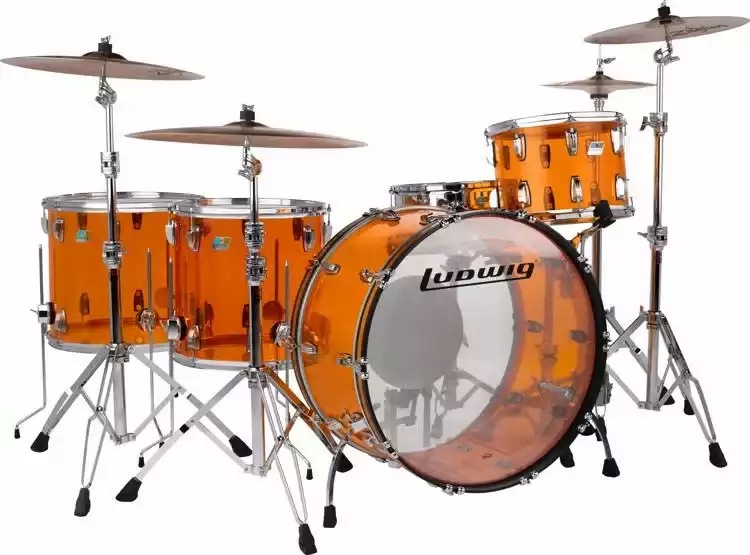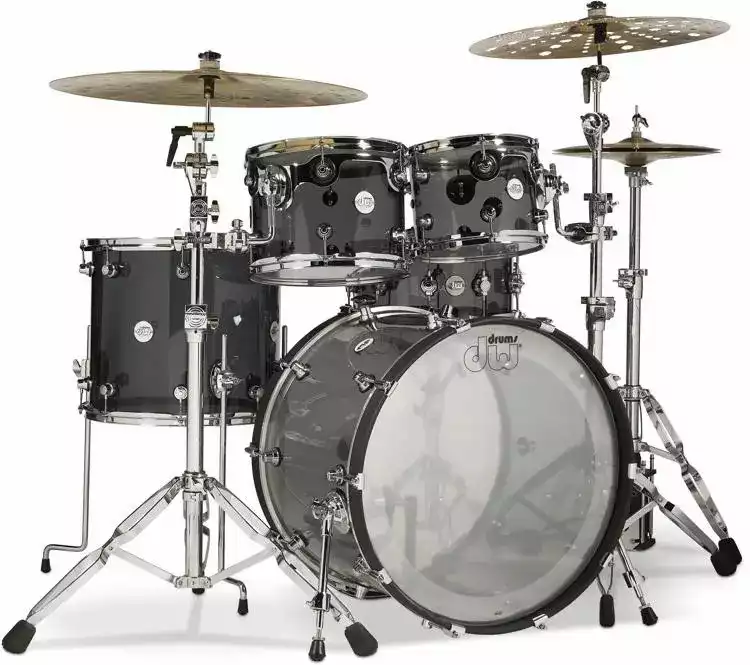Are Acrylic Drums Right For You? Pros And Cons Explained


While the acrylic material may make for great looking drums, is it worth using?
Acrylic drums are great for certain types of music with their clear and focused tone.
They’re typically lighter in weight compared to other kits which is great for travel and gigs. While their unique sound and characteristics may not fit every style of music, acrylic drums certainly have a place among some of the best drum kits on the market and in this article I will dive deeper into a few of the pros and cons of acrylic drums.
Table of Contents
First of all - what exactly are acrylic drums?
Acrylic is a clear, plastic material, also known as a thermoplastic.
This type of material can be shaped and molded with enough heat applied to the plastic and will retain its shape when cooled. Because of its ability to retain shape, this makes acrylic an ideal alternative to traditional wood drum shells.
The thermoplastic nature of acrylic leaves the material vulnerable to warping and deformation at higher temperatures, as well as making any cracks, scuffs or any kind of physical damage easily noticeable compared to most other drum sets.
This doesn’t mean that acrylic drums are fragile and hard to care for - it’s quite the opposite, actually. The plastic material is generally harder to damage, but on a transparent set of drums it would be easier for the human eye to naturally catch imperfections on the shells.
Related: here's how much a drum set costs (including acrylic drums).
The pros of acrylic drum sets
Pro 1 - their sound makes them ideal for certain types of music
As mentioned above, acrylic drums have a clear and focused tone and are great for certain types of music such as rock, metal and especially pop music.
The resonance of the snare and toms have a quick attack and to use the Ludwig Vistalite bass drum as an example, the larger 14” x 26” bass drum brings a low, deep tone. John Bonham used to play an acrylic set and he’s known for his deep, powerful bass drum playing.

To get an idea of how acrylic drums sound without leaving the comfort of home, this video from Drum Center of Portsmouth compares a few drum sets using a variation of different microphone setups that do a great job of capturing the range and tones of acrylic drums:
Pro 2 - acrylic drums are light and easy to move
This plastic material is lightweight and easy to move around, making it perfect for the gigging drummer that wants a flashy kit to catch the eye of the audience and not strain themselves when hauling the kit on and off stage multiple nights a week.
Note: if you plan on using acrylic drums for gigs on a regular basis then you will want to invest in a set of hard cases, which are usually more expensive than soft cases.
Pro 3 - they look great on a stage
When colour is added to the acrylic, the drum set really pops and has a unique look, especially if the drums are under stage lights, or even lit from below.
Most rock, metal and pop music concerts are full of energy, colourful lights, dancing and good times. This is a perfect mix for the loud and punchy sound of acrylic drums and their colorful, transparent aesthetic.
As a drummer myself, my opinion may be slightly biased, but when I walk into a venue and see a colourful set of acrylic drums on the stage I already know it’s going to be a good show.

Pro 4 - acrylic drums are easy to maintain
In general, acrylic drums are easy to maintain. They are less prone to dents and cracks than wooden shells, due to the fexlibility of the plastic.
Because of the see-through nature of the shells, it will be easier to notice smudges and dirt on the surface, but cleaning is a breeze, as all you need is mild soap and water to give the drums a basic clean.
Tip: here’s how to clean acrylic drums
For a more thorough clean, a pure cotton terry cloth and glass cleaner are a great combination.
If the shells get scratched then you’ll want to check your local hardware store for plastic polishing and abrasion-removal products. Just be sure that these heavy-duty cleaning products won’t damage the acrylic shells.

The cons of acrylic drum sets
Con 1 - acrylic drums’ sound can be less versatile
As mentioned above acrylic drums are great for pop and harder styles of music due to their “attack”, however they can have less “warmth” when compared to wood shells.
Generally for styles like jazz they might not be the best choice - of course you will still find jazz drummers out there who do like playing on acrylic sets, drumming is all about personal taste after all.
Con 2 - replacement parts can be tricky to find
Since acrylic drums aren’t as popular and widely used as wooden drums, it may be more difficult to find replacement parts.
Your best bet for acquiring replacement drumheads, hoops and lugs would be from the manufacturer. You may be able to find replacement parts from third-party suppliers, but availability may vary.
If you’re planning on purchasing a brand new acrylic drum set then it is always a good idea to check with the manufacturer to ensure that replacement parts would be available if needed.
It may be more difficult to find parts for older acrylic drum kits, as parts tend to be made differently over the course of time. In addition, some of the older models are less common and could have potentially used different parts altogether that are no longer in production.
It’s always good to ‘know a guy’
In my opinion, owning an older model of acrylic drums is similar to owning a vintage car that was sold in limited quantities, perhaps even from another part of the world.
It looks great, it will impress other people, it feels amazing owning it, but when something breaks you’ll need to put more effort into tracking down parts, or they may not exist at all anymore.
I know a few gear-heads and they always seem to know a guy who either has parts or can get parts, just like in the movies. If you’re into vintage drums, it’s always worth asking around at different local music stores to see if they’re able to help you track down parts.
Con 3 - Acrylic can warp at high temperatures
The nature of the thermoplastic material makes acrylic drums more susceptible to warping and deformation when exposed to higher temperatures.
It’s generally a good idea to avoid exposing the drums to temperatures at or above 100°F (38°C) for prolonged periods of time.
When it comes time to move the drums to a storage space, make sure to keep them away from radiators or direct sunlight. The warping can occur gradually over time, so the damage may not be immediately noticeable. It’s best to store acrylic drums in a cool, dry place, preferably in hard cases.
Tip: use hard cases for storage and transport
Acrylic drum kits require special care when storing and transporting.
It is highly recommended to use hard cases to avoid cracks, dents or scuffs.
If we take the sound factor out of the equation for a moment, the whole point of using acrylic drums is to show off a beautiful and flashy kit to the audience you’re playing for, right? Then of course you would want your acrylic drums to look spotless.
Soft cases are cheaper than hard cases and are a great option for most wood drum sets, but if you’re planning on taking your acrylic kit out of the practice space, you need hard cases.
I recommend something like the Protechtor drum cases to protect your acrylic drums during transport:

Conclusion
When it comes to acrylic drums and weighing the pros and cons, there are only a handful of things to keep in mind when it comes to the cons, such as only using them for certain types of music, investing in hard cases to protect the shells from damage, knowing where to get replacement parts and keeping the drums away from high temperatures to avoid deforming the shells.
If the music you’re playing fits the characteristics of acrylic drums then there is no reason not to play them, even if you only plan on playing the drums at home.
A colourful set of acrylic drums never gets old on the eyes and with the loud and focused sound of the drums themselves, you’re going to have a blast making noise with them.
Go to your nearest music store that sells acrylic drums and (politely) ask the drum technician if you can take the drums for a test drive - you won’t be disappointed.
Who we are
AboutDrumming.com is run by a group of drum teachers, drumming professionals and hobbyists. We love all things drums, and when not drumming we spend our time adding more awesome content to this website!
Free tools
You may also like
- How Much Does A Drum Set (Acoustic & Electric) Cost In 2023?
- How to Practice Drums Without a Drum Set: Improve Your Skills at Home
- Electronic Drums: Pros & Cons You Need To Know Before Buying
- Best Drums For Toddlers: Wood, Electronic And Hand Drums
Affiliate Disclosure: When relevant AboutDrumming.com uses affiliate links (at no additional cost to you). As an Amazon Associate I earn from qualifying purchases.